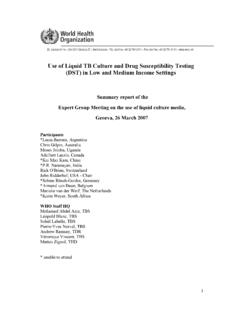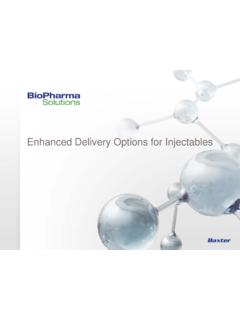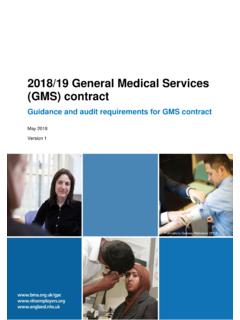Transcription of GLI GUIDE - Stop TB Partnership
1 GLI GUIDE to TB Specimen Referral Systems and Integrated NetworksGLI GUIDE to TB Specimen Referral Systems and Integrated NetworksiiiContentsCONTENTSA cknowledgements vAbbreviations viiBackground 1 Coordination of a Specimen Referral System 3 Planning for a Specimen Referral System 4 Phase 1: Detailed situational assessment of current specimen referral systems 4 Phase 2: Design of a specimen referral system pilot 5 Phase 3: Setup and implementation of pilot 5 Phase 4: Review of pilot 6 Phase 5: Scale-up of the specimen referral system 6 Phase 6.
2 Ongoing monitoring and evaluation, and continuous improvement 6 Key System Design Components 7 Management 7 Adequate laboratory testing capacity 7 Confidentiality of patient information 8 Transport options 8 Logistics and scheduling 8 Results return 9 Documentation including SOPs 9 Training and sensitization 10 Communication 10 Monitoring and evaluating quality and system performance 11 Other Considerations for System Design 13 Other uses of the specimen referral system, including integration 13 Use of network mapping optimization software 13 Costs and sustainability 14TB-Specific Considerations for Collection, Storage, Packaging and Transport 16 Case Studies 18 Case study 1: Integrated network for referral of TB and HIV specimens in Uganda 18 Case study 2: Steps for modelling a national integrated sample transportation network in Ethiopia 21 Case study 3: Sample referral system in Indonesia 23 GLI GUIDE TO TB SPECIMEN REFERRAL SYSTEMS AND INTEGRATED NETWORKSiv Case study 4.
3 Introduction of sample transport tracking in Lesotho 26 Case study 5: Use of unmanned aerial vehicles (drones) for specimen transport in Madagascar and Papua New Guinea 28 Case study 6: Sputum sample transportation: Revolutionizing TB diagnosis in Zimbabwe 30 Case study 7: Sputum sample transportation system for drug-resistant TB diagnosis and treatment follow-up: Bangladesh experience 32 Case study 8: Sample transport and result retrieval: Nigeria experience 34 Case study 9: Specimen transportation system by community-based DOTS partners in Mozambique 37 References and Suggested Reading 39 Annex A: Collecting information for planning and evaluating an integrated specimen referral system 40 Annex B: Mechanisms for the transport of specimens 46 Annex C: Example of TB specimen and results flow 49 Annex D.
4 Examples of forms for specimen referral and transport 50 Example of a TB specimen referral register 50 Example of an integrated specimen shipment inventory log 51 Example of a TB specimen shipment inventory log 52 Example of a transport (chain of custody) log 53 Example of a TB specimen receipt and testing register 54 Example of a TB specimen rejection log 56 Annex E: Example of an SOP for TB sample conditions and transport for culture procedure 57 Annex F: Framework of indicators and targets for specimen referral systems 66 Indicators to be monitored at the referring facility 68 Indicators to be monitored at the referral laboratory 70 Indicators to be monitored by the courier as part of their service agreement 72 Indicators to be monitored at the regional or national level by the TWG or MoH 73 Annex G.
5 Requirements for TB specimen collection, storage, packaging, transport and documentation 75 Packaging and documentation requirements 75 Specimen referral for AFB smear microscopy 76 Specimen referral for Xpert MTB/RIF testing 77 Specimen referral for culture 77 Specimen referral for drug-susceptibility testing 80 Annex H: Overview of specimen transport regulations, guidelines and guidance 82vGLI GUIDE TO TB SPECIMEN REFERRAL SYSTEMS AND INTEGRATED NETWORKSA cknowledgementsThis GUIDE was developed as a collaborative product of the global Laboratory Initiative (GLI) Core Group.
6 Development was led by Thomas Shinnick and Wayne van Gemert based on an initial draft by Kameko Nichols, with contributions from Heidi Albert, Levan Gagnidze, Sabira Tahseen and Maarten van Cleeff. Critical review was provided by the following GLI Core Group members: Elisa Tagliani, Martina Casenghi, Alaine Umubyeyi Nyaruhirira, Petra de Haas, Lucilaine Ferrazoli and Amy Piatek. In addition, external contributions were provided by Stephanie Denamps, Maria Rosezoil Rioja, Marguerite Massinga Loembe, Sushil Pandey, Richard Lumb, Armand Van Deun, Jason Williams, Satoshi Mitarai, Stanley Chan, Janice Lo, Peter Yip, Sanjae Kim, Changi Kim, Soyoun Shin and Rumina Hasan.
7 Contributors of the case studies included Moses Joloba, Peter Small, Sandeep Meharwal, Stephanie Denamps, Maria Rosezoil Rioja and Maarten van Cleeff, with additional inputs from colleagues from the Clinton Health Access Initiative in Lesotho and reasonable precautions have been taken by the authors to verify the information contained in this publication. However, the published material is being distributed without warranty of any kind, either expressed or implied. The responsibility for the interpretation and use of the material lies with the reader.
8 In no event shall the authors be liable for damages arising from its and design was provided by minimum GLI is a Working Group of the Stop TB Partnership . Development and publication of this document were made possible with financial support from the United States Agency for International AFB Acid-fast bacilliBAL Bronchoalveolar lavageCPC Cetyl pyridinium chlorideCSF Cerebrospinal fluidDST Drug-susceptibility testingEID Early infant diagnosis of HIVGIS Geographic information systemGLI global Laboratory InitiativeHCV Hepatitis C virusHIV Human immunodeficiency virusIATA International Air Transport Association LIMS Laboratory information management systemM&E Monitoring and
9 EvaluationMDR-TB Multidrug-resistant tuberculosisMoH Ministry of Health MTB Mycobacterium tuberculosis complex bacteriaNRL National tuberculosis reference laboratoryNTM Non-tuberculous mycobacteriaNTP National tuberculosis programme PLHIV People living with HIV/AIDSSOP Standard operating procedureTB TuberculosisTWG Thematic working groupUAV Unmanned aerial vehicleWHO World Health OrganizationABBREVIATIONS1 BackgroundBACKGROUNDThe WHO End TB Strategy calls for the early diagnosis of TB and universal drug-susceptibility testing (DST), with ambitious targets that can only be achieved when all patients have access to modern diagnostics at or near the point-of-care, as well as access to more advanced testing available at regional or central levels.
10 Specimen referral systems play a critical role in ensuring access to laboratory services by allowing patients to receive care and treatment at one location, while their specimens are transferred to various levels of a tiered laboratory system for testing. Referral systems can efficiently increase access to diagnostics in areas where testing is not available, prevent the need and associated costs for patients to travel, and lead to equity in access to health care. Furthermore, for certain tests, centralized or regionalized testing and a robust specimen referral system may be more cost-effective than placing staff and procuring and maintaining equipment to conduct testing at lower a common way to refer to specimen referral systems is specimen transport systems, this terminology minimizes the importance of all of the other essential components involved in referral.









